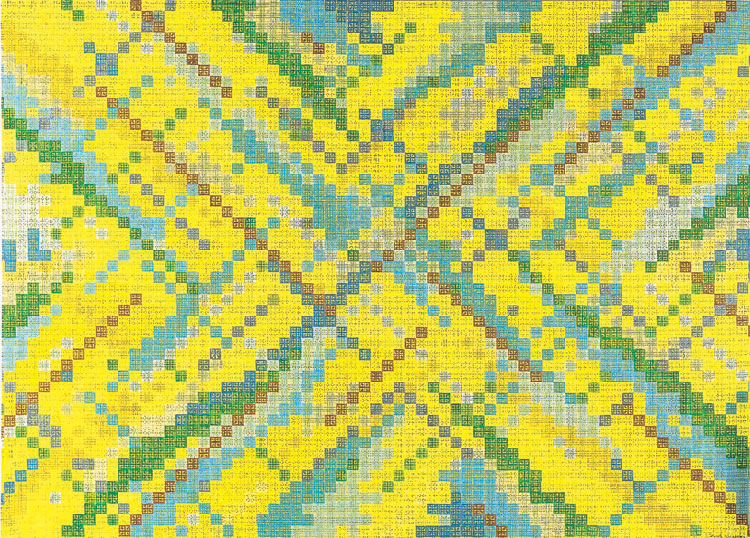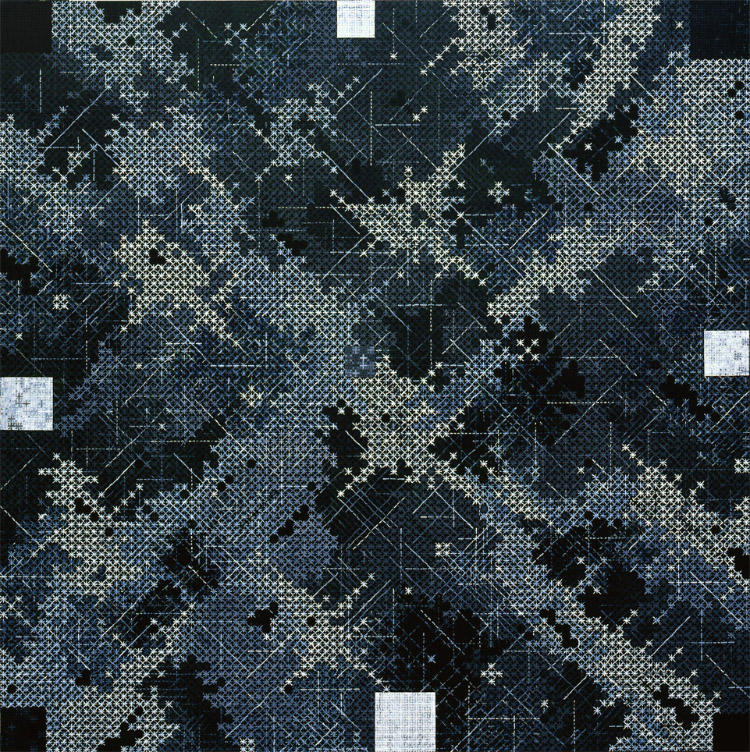|
|
 |
|||||||
精彩作品推荐
Editor's Recommendation
|
||||||||
| |
Articles on Ding Yi 丁乙评论及专访文章 / Ding Yi Exhibitions丁乙展览 |
| . |
| . |
|
.
|
Seeing, rather than perception |
Ding Yi's paintings in the context of European ways of looking at art |
Article Provided by Ding Yi Studio, Courtesy Ding Yi Studio It is striking how much space is devoted, in some writings about the work of the Chinese painter Ding Yi (born in Shanghai in 1962), to considering his artistic trade mark: the combination of two signs, x and +, in geometric patterns and their application both in terms of content and of painting technique. It happens less frequently, however, that these accounts open the way to understanding how Ding Yi reveals himself as a painter, in the context of the perception of the art of painting. So it seems appropriate to hazard, below, a modest and succinct attempt to situate Ding Yi and his work as a painter within the sometimes problematic perspective of contemporary painting and to do so from a European perspective. Ding Yi was one of the pioneers of what has been called the Chinese ‘New Wave Movement’, which emerged in cities such as Shanghai and Beijing in the mid 1980s. This was a revolutionary and fruitful period in Chinese art, a time when many Chinese artists broke radically with traditional artistic concepts and the social realism of the Cultural Revolution and eagerly embraced (so-called) Western modern art, which was oriented more towards the artist's individual expression. While Ding Yi felt attracted to the visual language of abstract modern art, he soon distanced himself from his Chinese contemporaries, who were primarily attracted by the individual expressive possibilities of Western modern art, and went in search of a visual language that would be "simpler, more impartial, and more rational". He himself says that he "found it necessary to distance myself both from the burden of traditional Chinese culture and from the influence of early Western modernism, in order to go back to the starting point of art, in order to literally start from zero". This was a daring statement, as Yi thereby seemed to fundamentally set his face against the possibilities of his own time and social context. The 1980s in China were, after all, years of strong economic growth that opened up – and by no means only in art – almost unlimited possibilities that many Chinese had previously regarded as impossible. In 1980s Europe, strangely enough, and more widely in almost the entire Western world, there was almost no sign of any such dynamic. Since the economic crisis of 1979 a sort of social nihilism had prevailed, which led, in political terms, to the arrival in power of a number of conservative governments in powerful countries. This malaise carried through to a great extent into the contemporary visual arts scene of the time, and especially into the world of painting. In the early 1980s an art-critical bomb exploded under the foundations of this age-old medium and painting was declared to be thoroughly dead. The main reason for this, in my opinion, was the fact that, since the rise of postmodernism in the early 1980s, painting could no longer relate to the discourse about its own (niche) medium, but at the same time had to win itself a place in a broader discourse, that concerning contemporary art in general. This ‘impotence’ caused a number of art critics of the time to conclude that this medium, within the interdisciplinary context of contemporary art, was no longer relevant and should, accordingly, be declared dead. Nonetheless, painting continued in that period to undertake desperate attempts to resist this impotence and to find a place for itself in the postmodern, contemporary, and interdisciplinary discourse. The intensity of this resistance manifested itself within the perception of painting in the polarisation between two ways of ‘looking at’ painting, two somewhat limiting and even peremptory ways, which even today it is hard to get away from in perception of art. On the one hand, it seems to have become almost impossible, from within the contemporary art scene, to look at and to interpret painting without meaning – in the semiotic sense of the word. For, since just about anything goes under the label of contemporary art and the interdisciplinary has become commonplace, the hysterical urge – both in terms of creation and in terms of perception – to provide an image, at all costs, with a meaning-bearing content seems to have become completely dominant; as a consequence, looking at a picture simply seems to coincide with the core aspect of communication: the picture conveys a particular meaning to one recipient or another, who then interprets this meaning as he or she sees fit. The consequences of this for painting seem to be legion. It is striking that these days, as regularly as clockwork, paintings are looked at in a more or less narrative and meaning-imposing way. The other point of view – which could almost be described as a reaction against that already described – is more inclined to take painting itself as its starting point and is perhaps best described as an intensely material outlook on painting – based primarily on paint and technique – in which the quest for meaning comes to depend on a sort of meta-medium reflection. In short, in the perception of painting a sort of dictatorship of context inspection seems to be taking shape, as a result of which it has become very difficult to seek out the twilight zone between the two bases of perception described above and under which the perception of painting seems to be unable to arrive at any consistent point of view proper to the medium itself. Seen from this perspective, accordingly, it would appear that the climate of the 1980s in China – a climate of progress and almost unlimited artistic possibility, within which Ding Yi developed his painting – was almost completely at odds with the climate of the time in Europe, where the perception of painting seemed to have run into a sort of crisis of identity. Thus, seen through European eyes, paradoxically enough, Ding Yi shaped his painting idiom within a history of perception that was characterised above all by its own imposed limitations within a number of ossified ways of looking at art. But perhaps it is precisely here that the power and relevance of Ding Yi's work in the context of the European perception of painting is to be found? His characteristic, stubbornly pursued position of independence within the Chinese New Wave Movement whereby – using an abstract, rational, and universal pictorial idiom – he resisted the new and growing striving for individuality of his Chinese contemporaries displays, after all, qualities that could supply a beneficial balm to the wounded European perception of painting. The first thing that strikes one when one looks at Ding Yi’s monumental abstract x and + paintings is their distinctly meditative nature. The fact that Ding Yi sometimes spends months working on a single painting, piling on layer after layer of hundreds of simple x and + motifs in geometrical patterns, requires an almost maniacal slowness. It is the sort of slowness that sees no other possible result than a profound trance, a conscious turning away from reality via the endless, repetitive, template-like action of painting. This mental, almost spiritually tinged slowness characterises, in my opinion, a mentality that inherently escapes from the polarised and limiting ways of looking at art – hysterical attribution of meaning as against intensive meta-medium reflection – of European painting. One of the inherent aspects of this sort of meditative, trance-like slowness in artistic practice is indeed, it appears to me, above all precisely about not striving for meaning – quite the contrary, in fact. A meditative attitude to painting seems to me to be more oriented towards freeing oneself from all kinds of peremptory ballast in terms of meaning; it is a mentality that aspires to a zero, a sort of "empty-of-meaning" diaphragm that no longer seems to be able to fill itself with anything other than universal essence. On the other hand, Yi's mental approach seems to also subtly disrupt the meta-medium reflection attitude to perception. The works of art that result from this intensely meditative approach seem, although from a technical point of view they are decidedly painterly in their aims, to want to be anything but paintings. Their endless, maniacal, and teeming accumulation of the most diversely presented x and + motifs transcend in their image construction the idea of looking at "paint on canvas", but assert, by contrast, a more universal, abstract image that withdraws from the material from which it is constructed and reflects, or not, on that basis. Ding Yi's works are no longer paintings; they are universally accessible realities in themselves. At the same time, these slow, meditative, and universal-abstract works do bear witness to a consistent return to craftsmanship, in the most classic sense of the word. Yi's endless series of constantly recurring motifs in varied but logically thought-out colours, created with meticulous attention to every tiny detail, draw, after all on a sort of patience that is more characteristic of, say, the late medieval craft ethos than of that of contemporary painting. The fact, moreover, that Ding Yi has made use for over a decade now of tartan material made by traditional methods shows, at the least, formal interest in handicrafts. And these qualities are another way in which Ding Yi's paintings succeed in skilfully escaping contemporary ways of looking at painting. Painting, after all, is rarely looked at these days from the point of view of purely craft thinking and action. As a rule, looking conceptually at the why of the way in which paint is applied to canvas predominates over its purely formal aspects. These inherent qualities of Ding Yi's work as a painter generate a perception of the image that could have a fundamental impact on the malaise that is apparent in the European view of painting. The slow, meditative, and trance-like generation of images in the context of a pronounced feeling for craft skills (re)creates, it seems to me, a way of looking at paintings that could be called decidedly atmospheric. Ding Yi's monumental paintings force us, as it were, to look from rather than look towards. The thousands of geometric motifs, interlocking in constantly varying ways, plunge the viewer into an all-embracing, highly sensitive atmosphere in which meaning generation, reflection on the medium, and rational inspection of context simply become impossible. For the simple reason that there is no longer any rational mental viewing distance. Ding Yi's canvasses become pure atmosphere, which appeals once more to the eyes instead of to the intellect. Their relevance (or perhaps even their "meaning") is to be found in the gaze itself, which always and everywhere precedes any other form of perception. Ding Yi negates every form of perception by re-establishing the act of looking itself – and that, in the context of contemporary painting, is not just a quality, but an art too. |
Thibaut Verhoeven Ghent, September 2011
|
 |
19.十示_2007-10_丙烯_成品布_200x280cm |
 |
32.十示_2011-4_丙烯,画布_300×300cm |
Articles and Photos Provided by Ding Yi Studio, Courtesy Ding Yi Studio |
. |
|
|
||||||||
本网站里所有网页设计的版权属纽约"中华文化艺术网" eChinaArt.com, Inc. 所有,文章、艺术作品照片版权属艺术家或作者本人所有。任何未经版权所有人许可的转载, 出版或借用都将被追究法律责任。eChinaArt.com,Inc© |
||||||||
